Vets’ Advice: Making Use of the Galliprant NOAH Datasheet
Vets’ Advice: Galliprant NOAH
Galliprant, the brand name of a product containing the active ingredient grapiprant, is one of several treatment options for dogs with osteoarthritis pain. The treatment is available in the form of a tablet for oral administration. When Galliprant arrived on the market in 2018, it represented a new class of medicine for the treatment of osteoarthritis pain in dogs.
Getting to know the Gilliprant NOAH datasheet
When a new medicine comes along, a vet will need to get to know it, learn how to use it and understand how it relates to already familiar treatments. Questions a vet might ask about a new treatment are: Should it replace what I already use? Is the new treatment of particular use in certain patients? What is the dosage? How do I monitor the effects of the treatment? What side effects can be expected?
Some of these questions can be easily answered by consulting the Galliprant summary of product characteristics (SPC) or Galliprant NOAH datasheet. The Galliprant SPC is the regulatory agency-approved information on using the product. You can easily find the SPC in the product information database of the veterinary medicines regulatory agency (the Veterinary Medicines Directorate). The same information is reproduced in the Galliprant NOAH datasheet compendium.
How the Gilliprant NOAH datasheet helps prescribers
The Galliprant NOAH datasheet or SPC offers a wealth of essential information to support the veterinary prescriber.
The licensed use. For Galliprant, the licensed use is “the treatment of pain associated with mild to moderate osteoarthritis in dogs.” This means that use in dogs with severe osteoarthritis is off-licence or off-label - and therefore unlicensed use.
The likelihood of adverse effects associated with the treatment. The Galliprant NOAH datasheet and SPC list vomiting, loose stools, diarrhoea and inappetence as the most commonly reported adverse effects.
The Galliprant NOAH datasheet and the SPC specify dosage according to body weight, and the documents advise on how soon to expect a treatment response.
How likely is it that a dog with mild to moderate osteoarthritis will respond to Galliprant. To give an indication of what to expect, the Galliprant NOAH datasheet and SPC include a summary of the results of the pre-marketing clinical trials.
The Galliprant NOAH datasheet and SPC include advice on when the product should be used “with caution”, such as in animals with heart or liver dysfunction.
What else do prescribers need to know?
A new medicine like Galliprant is not the only treatment option. Before it came along, vets were already used to using existing products, particularly the long-established non-steroidal anti-inflammatory drugs (NSAIDs). It is therefore obvious that a prescriber would be interested to know how the new treatment compares with the familiar existing options and when it is best to use the new treatment in relation to other options. This is an aspect on which the SPC and datasheet is not so helpful and where there is a need to search more widely for comparative information from published clinical trials.
Answering clients’ questions
The Galliprant NOAH datasheet and SPC are also very helpful for answering questions that clients might ask. For instance, should Galliprant be administered with food? For many medicines, whether or not there is food in the stomach makes no difference. But Galliprant is one of the few veterinary medicines where it does matter. The Galliprant NOAH datasheet and SPC is very clear on this. Galliprant must be given on an empty stomach (e.g. in the morning) and at least one hour before the next meal. The explanation for this is also in the Gallliprant NOAH datasheet and SPC – in the section on pharmacokinetics.
Use up to date information
The Galliprant SPC and, in turn, the Galliprant NOAH datasheet are updated from time to time when significant new information becomes available. Consequently it is important to refer to the most recent version of the document. As well as publishing independent critical reviews of new medicines in the form of multimedia CPD modules, Veterinary Prescriber helps veterinary professionals to keep up to date on medicines in the monthly Medicines News. The Medicines News alerts subscribers to changes to the authorised product information and lets them know when new products are marketed, including an explanation of the practical implications of any new products. The Medicines News also includes information about changes to veterinary medicines regulation, about product reclassifications and also includes ADVET – what the adverts say and what they’re not telling you – a unique and critical look at promotional claims for veterinary medicines.
To find out more about how Veterinary Prescriber helps keeps vets informed and up-to-date, visit the Virtual Veterinary Medicines Academy and to about how Veterinary Prescriber produces independent medicines information head over to the About page.

